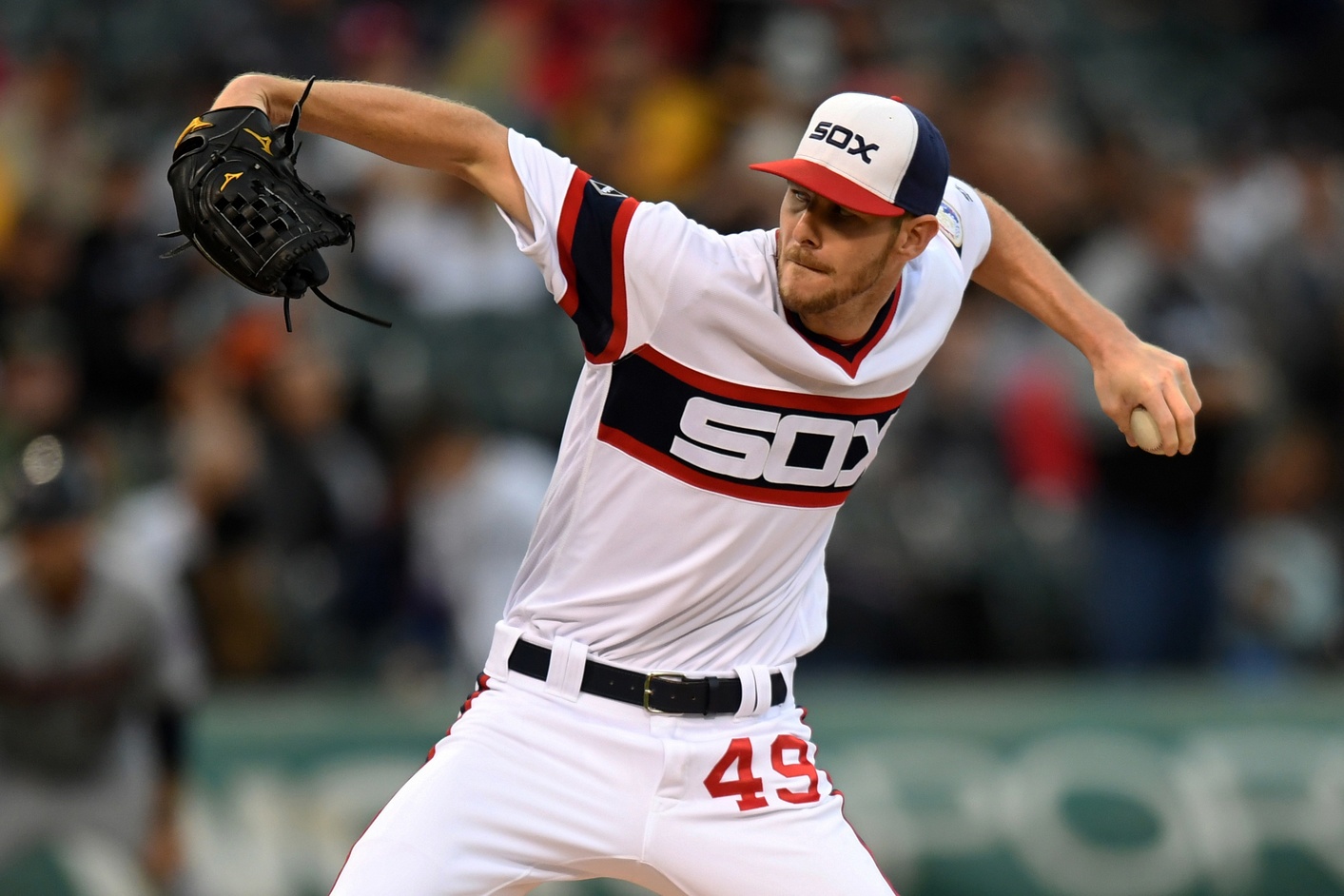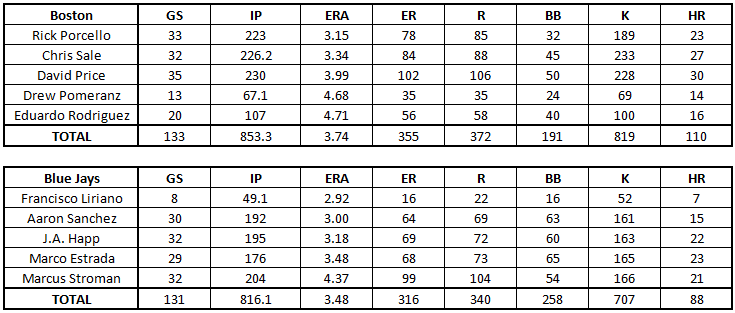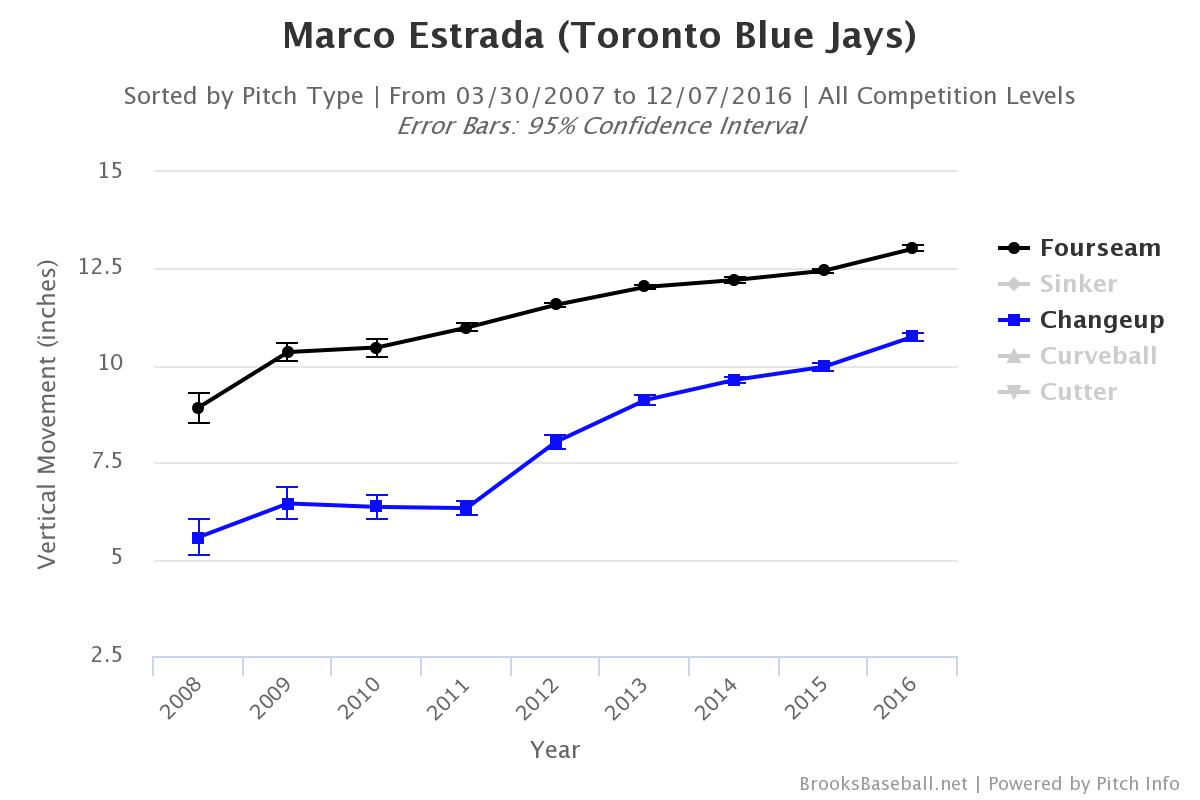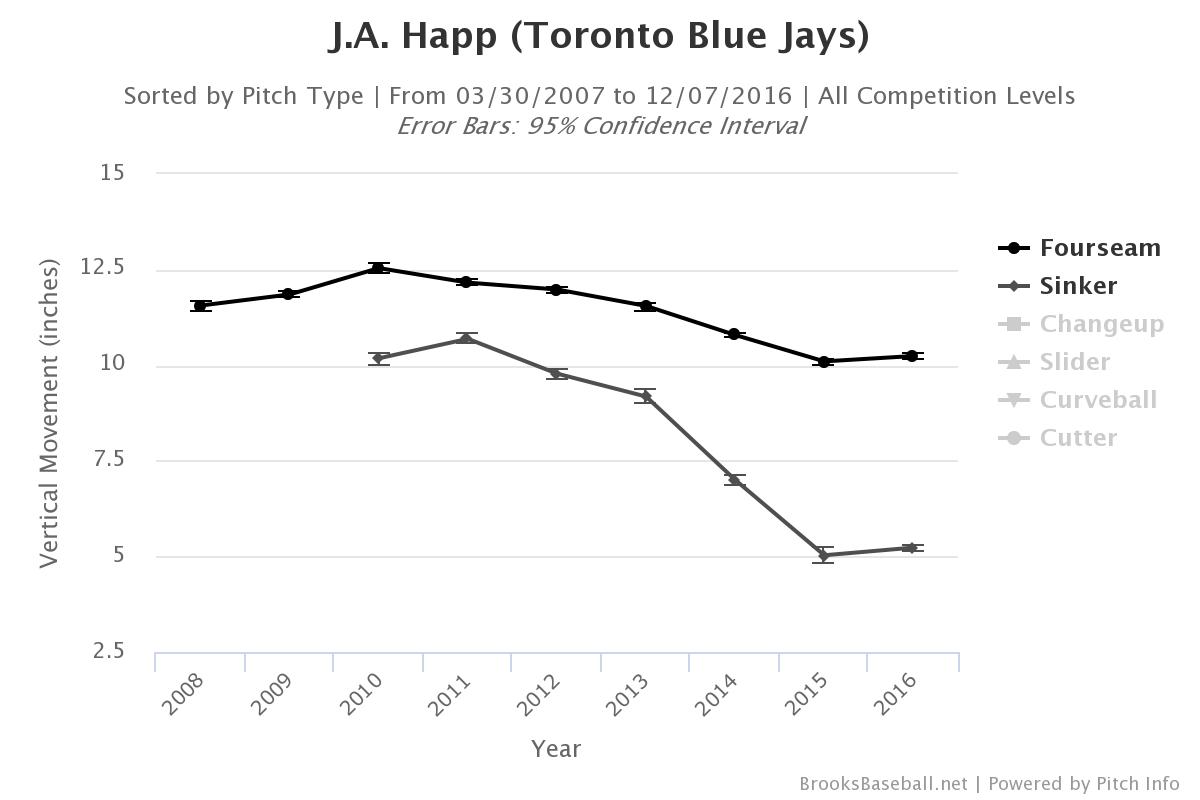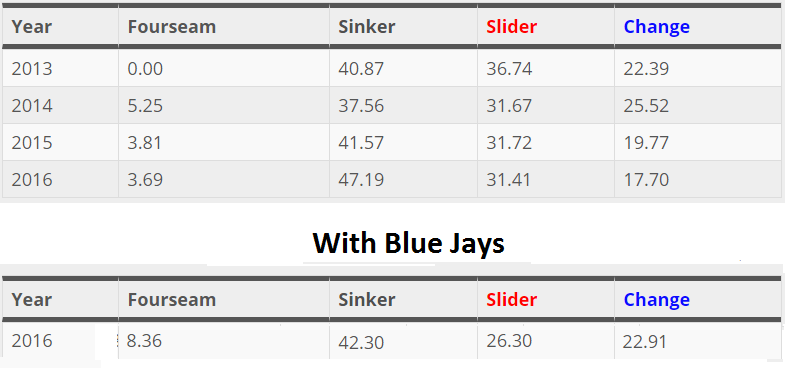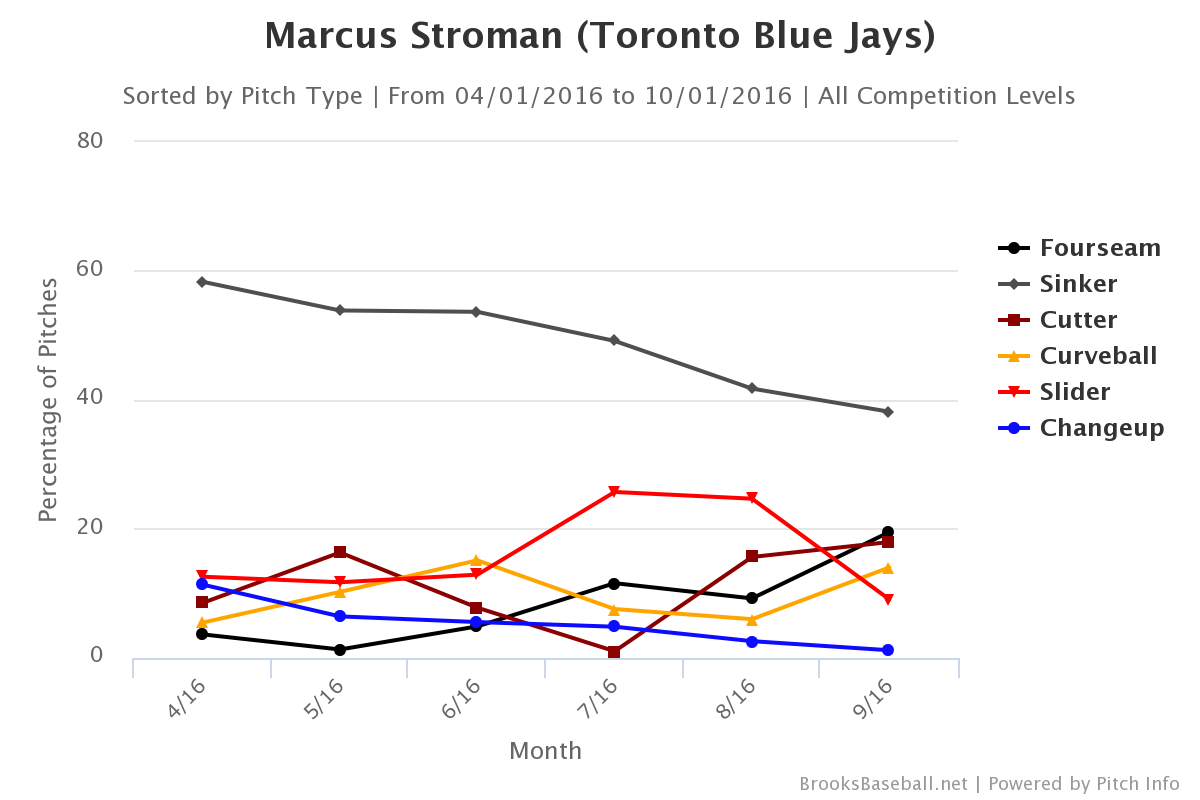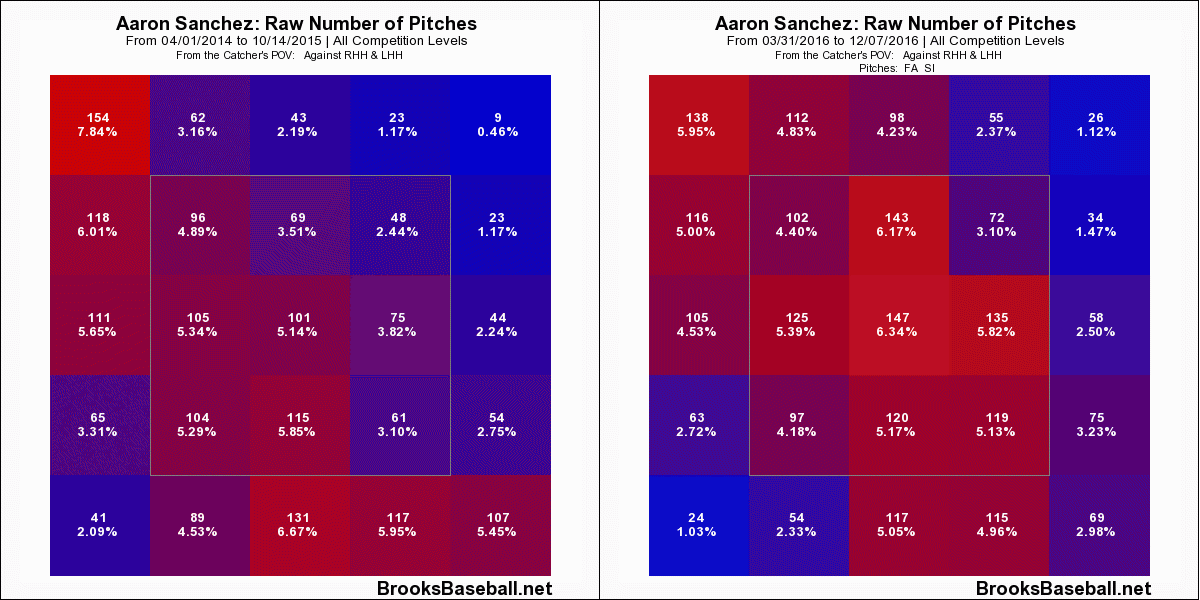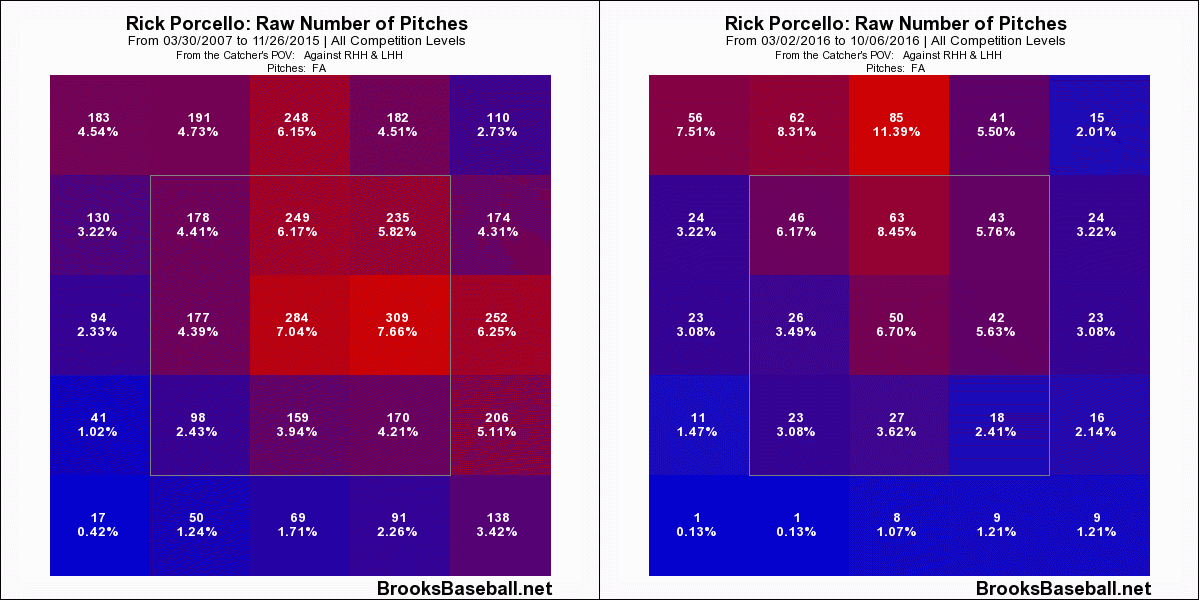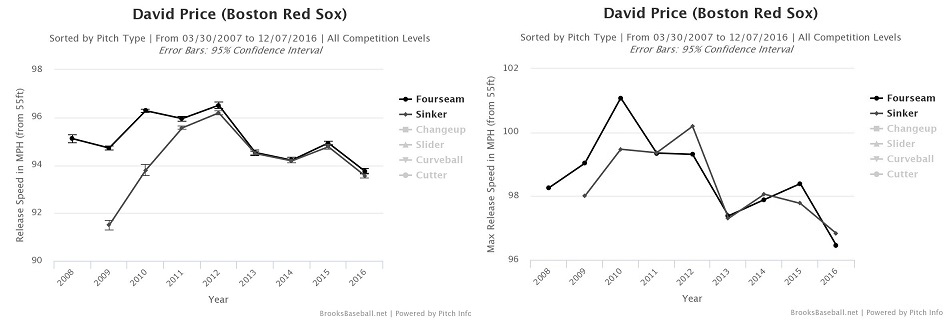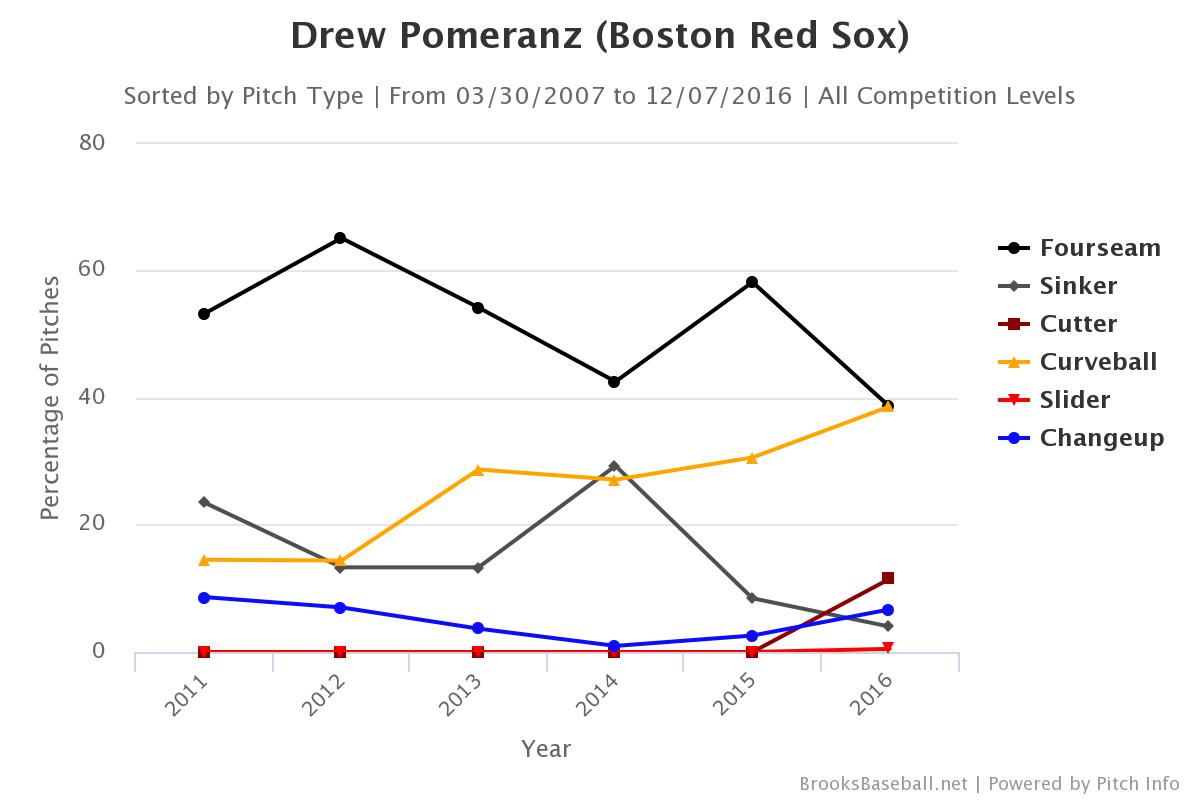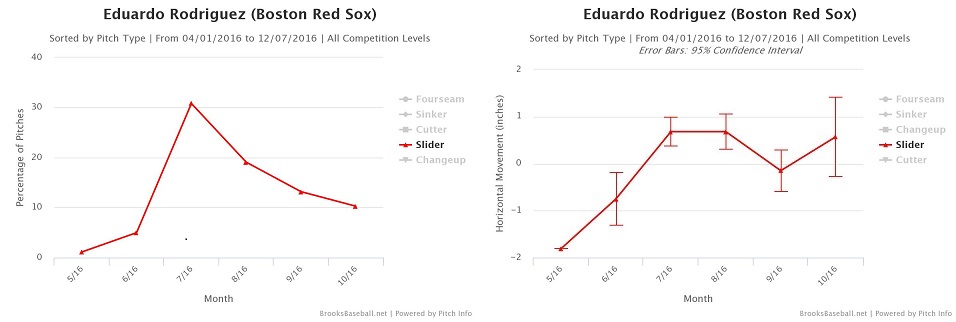It sounds crazy. The Red Sox just traded for Chris Sale. Rick Porcello just won the Cy Young Award (even though he shouldn’t have). David Price could be their third starter. That rotation should scare every team in the American League. And yet, I’m here to say that it might not even be the best in the division.
The simple way would be to just stick Sale on the Red Sox from last year and see how things would turn out with the projected five starters based on their work in Toronto/Boston.
Hooray! The Blue Jays pitchers have the better ERA! It’s over!
Obviously you come here for better analysis than that, and some of those numbers are very cherry-picked (no bad Pittsburgh Liriano, no good San Diego Pomeranz), but it actually provides a decent starting point. The Jays pitchers DID outperform their Red Sox counterparts. It’s a matter of whether they can do it again.
The Jays pitchers may not have the sexy names, or the big time strikeout to walk ratios, but they possess traits that have actually made them really, really good at run prevention. While Boston does have a bunch of big time strikeout pitchers, some of their arms did show a few red flags that hurt their numbers and could carry over into 2017.
I’m going to break down each club’s expected rotations to look at how they project out for the upcoming season.
Blue Jays
It’s not hard to see the extreme upside in the Jays rotation. Four of the five starters have received Cy Young votes in the last few years (sorry Marcus!), and they led the league in ERA as a group just last year. They’re also replacing R.A. Dickey’s mediocre production with Liriano.
Unfortunately, on the surface, those numbers up top also scream for some potential regression. The only pitcher with an above league-average K/9 was Marco Estrada. Four of them had opposing BABIPs under .270. Those same four guys had DRAs well above their ERAs (You’re doing better here, Marcus!). However, there are reasons to believe each of those guys can continue to outpitch their peripherals.
Marco Estrada
When it comes to regressions candidates, the first person people always point to is the soon-to-be 33 year old Estrada. One would think that back to back seasons where he has stymied AL East foes with his fastball-changeup combo would convince people that he is for real, especially since the strikeouts came back. However, his league-low BABIP of .234 was 2.3 standard deviations away from the league mean among starters (.292) in 2016. That makes two years in a row that he has been extremely far from the norm in the category (.221 and 3.1 SDs in 2015). Typically, that screams “good luck” that won’t be repeated, or suggests that a team had otherworldly defence.
We can dismiss the latter effect right away. While the Jays do have one of the game’s best defenders in Kevin Pillar (21 DRS), his impact was almost completely negated by having two of the league’s worst everyday outfielders on his flank in Jose Bautista (-8 DRS) and Michael Saunders (-11 DRS). The Jays have good infielders, but Estrada doesn’t see much benefit with his 35 percent groundball rate.
As for the “luck” factor, as I broke down here, here, and here, Estrada’s unique “rise” on both his fourseam fastball and changeup led him to post a popup rate (16.2 percent) that was 3.7 standard deviations better than the MLB average. Those numbers are increases over his 2015 totals (14.5% and 3.1 SDs), but this actually makes sense with his increased movement.
As his ball continues to fight gravity, his lazy flyballs increase which help him outpitch his peripheral stats. The fact that this skill can be easily identified suggests that it’s repeatable, and as such very little regression should be expected from Estrada. In fact, improved outfield defence could even improve the numbers for the “popup pitcher”.
J.A. Happ
Right after Estrada on the list of “he was just lucky” pitchers is 2016’s surprise Cy Young candidate:, J.A. Happ.
After bouncing around as a back of the rotation starter for years, Happ finally seemed to find himself after a 2015 deadline deal to Pittsburgh. Ray Searage worked with Happ to clean up his delivery, and he dominated for two months. He took things to another level in his return to Toronto, where he was able to post a career high in innings while posting a career-best (as a starter) 3.18 ERA.
Like Estrada, there is an identifiable reason for his success in outpitching his peripherals. Also like Estrada, Happ uses special fastball movement to generate favourable results.
Once again, you can read this in more depth here, but J.A. Happ just happens to have a unique fastball. Or should I say set of fastballs. With a “rise” of 10.2” on his fourseamer and 5.2” on his sinker, J.A. Happ gets more separation between the two pitches than any other qualified starter (500+ of each pitch) in the game.
This means that even if the hitter guessed fastball, the unpredictability of the movement still had him at a disadvantage. By combining the two offerings effectively, Happ gets grounders when he needed to (a career high 21 double play grounders), while also jumping the swing and miss rate on his fourseam by over nine percentage points from his previous average as a full-time starter.
This was his first season doing this, so it’s possible there could be some slight regression coming, but the unique nature of his arsenal should mitigate the overall effect. Like Estrada, improved corner OF defence could also help Happ’s overall numbers.
Francisco Liriano
Francisco Liriano has the widest range of outcomes. I could tell you he’s going to be the best starter on the team, or the worst, and I guarantee I’d get a large chunk of people who would agree with me either way.
Where there should be little disagreement is that Liriano is going to take a small step backwards from his time with the Jays at the end of the season. His 2.92 ERA and 2.9 BB/9 would be the best marks he has put up in since his early career in Minnesota when people viewed him as the next Johan Santana.
There’s also the fact that he was absolutely shelled last year in Pittsburgh. The interesting thing there is that the outliers were in the completely opposite direction. His control went in the complete opposite direction (5.5 BB/9). Now, that’s not exactly a crazy notion when it comes to the notoriously wild Liriano, but his walk rate over the previous three years had stabilized and was down to 3.8 per nine from his five plus years with the Twins and White Sox. The Jays bet on that being the real guy and hit in a big way.
It wasn’t just pure regression that the Jays were betting on though. Take a look at the following chart (Pittsburgh on top):
When Russell Martin was Liriano’s catcher with the Pirates, he made a point of having the power lefty use his changeup liberally. Over the last couple of years that has declined, before cratering in favour of the fastball last year. When Liriano came to Toronto, Martin made him start throwing it again and his command improved. It’ll be interesting to see if he can make that continue.
The safe money would be on Liriano pitching much more like the player he was from 2013-2015 (3.26 ERA, DRAs of 2.90, 3.56, and 3.22). That’s probably a 3.50-3.75 ERA guy in the AL East with this team’s infield defence and Liriano’s groundball rates (52% or higher the last 4 years).
Marcus Stroman
Marcus Stroman’s results were pretty bad. His 4.37 ERA was barely better than R.A. Dickey, he averaged over a hit allowed per inning, and his strikeout rate was only 7.3 per nine. However, like Liriano’s Pirates numbers, there are reasons to expect much better numbers from Stroman in 2017. His DRA alone (a team-best 3.43) suggests there was more.
Marcus Stroman debuted a new sinker when he returned in 2015 that had people comparing him to Roy Halladay.
Given the extreme movement on the pitch—it has the most sink in all of baseball among qualified starters— Stroman started the season featuring it heavily. Three months in and the results weren’t good: his ERA was 5.33 and his K/9 was 6.3. The sinker had a ton of movement, but he threw it so often that players could sit on it. As a high contact offering, he was just getting killed with balls going through holes.
He forgot that what made him partricularly special was his possession of many plus pitches. It seems someone reminded him of this fact when the calendar turned to July.
Starting in July, Stroman started throwing his slider a lot more, and then started featuring even more of his offerings as the season went on. With hitters no longer able to just sit on the same pitch, everything in his arsenal played up. For the rest of the season, his strikeout rate was a very respectable 8.3. When combined with his still extreme groundball rate, Stroman posted an ERA of 3.42, which was much closer to what people expected out of the diminutive hurler.
Given his previous success and the change in repertoire, it seems likely that this is much closer to the real Marcus Stroman than the player we saw in the first half of 2016.
Aaron Sanchez
Aaron Sanchez is a bit easier to explain. The 24 year old finally had his shackles removed and all he did was lead the American League in ERA. His added bulk and improved mechanics helped him reach a career high in innings (192) and lower his walk rate down to a very manageable three per nine.
The skill was always there, as Sanchez’s power sinker had made numerous hitters look extremely stupid. However, while he had always dominated same-sided hitters, the issue was his ability to get lefthanders out. In 2015, lefties hit the Californian righty to the tune of .282/.390/.488. That’s pretty bad. He certainly turned that around though. In 2016, they hit .217/.306/.352. That’s good.
The sinker is a pitch with pretty heavy platoon splits. When he was a reliever, Sanchez almost threw the two seamers exclusively. In 2016, he started expanding his repertoire, and it really helped him against southpaws.
The two biggest differences were his curveball and the development of his changeup, but he also showed an increased willingness to pitch inside with his fastball.
The fastballs in combined with the breaking balls away made for a pitcher who could really keep lefties at bay. With his continued destruction of righties, Sanchez became a true top of the rotation pitcher.
He does still rely on getting outs on the ground, which is somewhat susceptible to random variance. As such that 3.00 ERA should regress some. Though Sanchez is still an elite arm, and he should be able to go to 220 innings this year if he has to, which is a huge plus for Toronto.
BOSTON
Chris Sale
Chris Sale is awesome. He’s the best pitcher on either of these two teams. I don’t think I need to spend a ton of time on him, but there are a few interesting notes.
First, he’s moving to a better hitters park. While Comiskey (the name changes so often I’m just using this) has historically been a hitters park, it actually played as a pitchers park the last few years. Meanwhile Fenway is as good of a hitters park as exists in the American League.
Sale’s extreme bat-missing abilities and control certainly help mitigate this effect, but they don’t eliminate it completely. His results once hitters make contact should go up a little bit.
There was also some thought that he whould also be helped by simply getting away from Dioner Navarro. As Jeff Sullivan wrote over at Fangraphs, Sale’s catchers killed him last year, and game calling won’t get much better with Sandy Leon being the plate. As a flyball pitcher, though, he will get some boost from the excellent work done by Jackie Bradley Jr. in that large center and right field in Boston.
All that said, Chris Sale is really good and we should expect him to be basically what he has been the last few years.
Rick Porcello
The reigning AL Cy Young winner took a huge step forward in 2015. He put up career-bests in tossed innings (223), ERA (3.15), K/BB (league-leading 5.91), and strikeouts (189). It was an incredible season, and while he didn’t deserve the award he won, he was one of the league’s best starters.
There wasn’t much of a change in repertoire that led to his monster season, but there was a change in approach.
In 2016, Porcello started working heavily up in the zone with his fourseam fastball. This helped him get more swings and misses on the pitch (career best 15.5%), and also throw more strikes. It also turned Porcello into something of a flyball pitcher.
This made some sense with the expansive RF in Fenway, and came with more infield popups (though only slightly more than average), while not having a huge effect on his home run rate (the HR/FB was about average).
He probably falls back a bit just simply due to the extreme BABIP luck and no clear reason for him to fall all the way to .269 from a career .307 (he should drop some due to more FBs), but he’s likely going to be something close to a 3.50 ERA guy in 2017.
David Price
Price is by far the most interesting member of the Red Sox rotation. Expected to be a true number one pitcher and lead Boston to the World Series, Price stumbled in 2016. His 3.99 ERA was a career-worst which also came with all-time high hit and HR/9 rates. His strikeout rate of 8.9 was also a three year low. The strikeouts were high in the awful first half, but they were lower in his better second half. In short, he wasn’t “David Price.”
While there is obviously expected to be some regression back to his career levels, there was one very big red flag associated with Mr. Price.
Price’s velocity fell to an all-time low of 93.75 mph; that’s bad. It wasn’t some blip either as he started down and finished there.
To compensate, Price threw more cutters and changeups than ever before. They’re both very good offerings from the big lefty, but the need to reinvent himself during a season where he underperformed is a very worrying sign for Red Sox fans.
There are some indicators that would normally project that some regression will occur, but even those come with red flags. His HR/FB rose from a career 9.6 percent to 13.5, and his BABIP from .290 to .310. Those should suggest he was somewhat unlucky. Unfortunately, he was also hit a lot harder.
His overall exit velocity rose from 87.7 to 88.3, but he got crushed on line drives. His exit velocity on line drives and fly balls rose 1.5 mph from 90.9 to 92.4 mph. That’s going to lead to more hits and to more home runs.
While David Price track record suggests he’ll still regress a bit back to normal, if he doesn’t get that fastball back, he’s not an ace anymore.
Drew Pomeranz
2016 was Drew Pomeranz’ first year as a full-time MLB starter and he didn’t disappoint. Pomeranz put up a 3.32 ERA with two teams, a career-best strikeout rate of 9.8 per nine, and even made his first All-Star team. Aside from simply making more starts, there was a very clear reason for Pomeranz’ increased success: his curveball.
His nine inches of drop on the curveball is 10th most among starters. Among starters who thew over 500 of them, he’s third. Over 550, first. He has a good curveball, and he likes to use it. Hitters miss on 31.7 percent of the swings they take at Pomeranz’s curveball. With San Diego, batters hit just .201 with a .262 slugging percentage against the offering, so even when they did hit it, they couldn’t do much with it.
Drew Pomeranz absolutely dominated using this strategy with the Padres, but things didn’t go quite as swimmingly in Boston. While AL batters still missed the pitch at a 32 percent rate, they did damage when they connected, hitting .264/.364 against the hook. They also teed off on his other offerings, with an ISO of .314 against his fastball and .303 against the cutter.
It would be easier to decide what to do with Pomeranz if he had recovered fully at some point after the deal, or simply never recovered. After giving up 12 runs in his first 14 innings in a Red Sox uniform, Pomeranz posted a 2.70 ERA in August. Then September rolled around and he failed to pitch six innings in any of his four starts, allowing 12 runs in 16 innings, and giving up five home runs. His only two decent outings that month were on the road in San Diego and Tampa (who also play in a notorious pitcher’s park). In the postseason he only lasted 3 2/3 innings. He struck out seven, but he also gave up two runs including a home run.
Pomeranz may still be an elite strikeout pitcher, but he also gives up his share of flyballs, and that’s going to mean a lot of home runs in the AL East. Yes, he’ll benefit when the ball goes to RF, but as a left-handed pitcher who will face lots of righties, the ball will more often be heading towards the green monster.
His numbers will get better than the disastrous 4.59 showing with Boston, but they may not break the 4.00 barrier and almost certainly won’t top 3.50, and he hasn’t gone deep into games.
Eduardo Rodriguez
Here is the absolute best progression candidate for the Red Sox rotation. Rodriguez’ overall season numbers were bad, but the 23 year old was coming off an injury to his landing knee, and his early results skewed the results heavily.
In his first six starts, Rodriguez posted an 8.59 ERA across 29 1/3 innings. Across his last fourteen outings, he posted a 3.24 ERA, a 9.2 K/9, and allowed more than three runs only twice. Now, normally you can’t just take out the first six starts of a guy’s season and proclaim greatness, but with Rodriguez there’s a very real reason: He couldn’t throw his best pitch.
In the first few outings back from injury, Rodriguez’ slider wasn’t getting the horizontal movement he expected (graph on right), so he didn’t throw it (left). Without the slider in his arsenal, hitters were able to sit back on the fastball/changeup combo, and they hit the young southpaw hard. When he started throwing the slider again at the start of July, his performance immediately took off. This follows logically, since his miss rate on the pitch was 30.7 percent of swings until the end of the season.
He doesn’t generate many groundballs, so he’s likely always going to be susceptible to the home run, but Rodriguez should probably be expected to put up a mid 3.00s ERA in 2017: he’s good.
CONCLUSION
In the end, there’s few reasons to suggest that the Blue Jays starters as a whole would be any worse than they were in 2016, save for health. Marcus Stroman should be much better, while Liriano and Happ could fall back a little.
It’s a rotation that could have four pitchers at or around 3.50 ERAs, with one guy in the low 3.00 range (Sanchez). Three of those guys should be able to throw 200 or more innings (Stroman, Sanchez, and Estrada), while a couple of the lefties could top around 180-190 or so (Happ and Liriano).
On the Boston side, Sale is likely to be mostly the same guy he always has been, and Rodriguez should take a big leap. Pomeranz will improve on his Boston numbers, but likely not to his SD levels, Price should improve a bit, but not to his former ace levels. Porcello should take a tiny step back, but not a notable one.
It’s a rotation that could also have four pitchers at or around 3.50 ERAs, with one guy in the low 3.00 range (Sale). Three of the guys should be able to throw 200 or more innings (Price, Porcello, Sale), while a couple of the lefties could top around 180-190 (Pomeranz and Rodriguez).
Those sound kinda similar, don’t they? The Red Sox have the best guy (Sale), but the Jays could have three of the next four best (Sanchez, Stroman, Estrada vs Porcello and Price). Boston has more depth with Steven Wright and Clay Buchholz, which should help them as the injuries roll out. However, in the end, Boston and Toronto’s rotations are going to perform much closer than you’d think.
Lead Photo: Patrick Gorski-USA TODAY Sports
